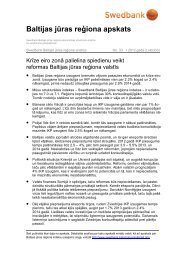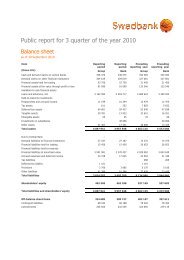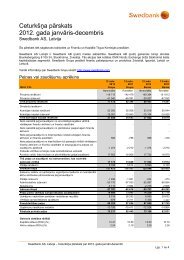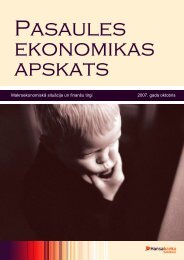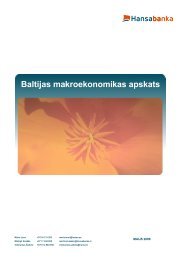Fulfilling the Maastricht criteria - Swedbank
Fulfilling the Maastricht criteria - Swedbank
Fulfilling the Maastricht criteria - Swedbank
You also want an ePaper? Increase the reach of your titles
YUMPU automatically turns print PDFs into web optimized ePapers that Google loves.
<strong>Swedbank</strong> Analysis August 1, 2012<br />
<strong>Fulfilling</strong> <strong>the</strong> <strong>Maastricht</strong> <strong>criteria</strong> –<br />
mission possible for Latvia and Lithuania?<br />
<br />
<br />
<br />
There are five main <strong>criteria</strong> for <strong>the</strong> ECB and <strong>the</strong> EC to<br />
use in judging whe<strong>the</strong>r a candidate country is ready to<br />
adopt <strong>the</strong> euro: price stability and interest rates (<strong>the</strong><br />
moving-target <strong>criteria</strong>, as <strong>the</strong>ir reference values<br />
change), government budget deficit and debt, and exchange<br />
rate stability. Compliance with all of <strong>the</strong>m<br />
should be done in a sustainable manner. Despite <strong>the</strong><br />
well-known shortfalls of <strong>the</strong>se <strong>criteria</strong>, <strong>the</strong>y are unlikely<br />
to be changed in <strong>the</strong> near future.<br />
Calculation and interpretation of <strong>the</strong> moving-target <strong>criteria</strong><br />
have been uncertain and not always done in a<br />
symmetric way for all <strong>criteria</strong>, and, hence, <strong>the</strong> outcome<br />
is difficult to predict. Moreover, <strong>the</strong> so-called o<strong>the</strong>r<br />
relevant factors used to supplement <strong>the</strong> five main <strong>criteria</strong><br />
to evaluate sustainability of <strong>the</strong> convergence and<br />
readiness to join <strong>the</strong> EMU have not until recently been<br />
explicit and <strong>the</strong> stance of <strong>the</strong> ECB and <strong>the</strong> EC has<br />
sometimes differed.<br />
Both Latvia and Lithuania have good chances of fulfilling<br />
<strong>Maastricht</strong> <strong>criteria</strong> in April 2013 to be able to adopt<br />
<strong>the</strong> euro in 2014. The chances of meeting <strong>the</strong> <strong>criteria</strong><br />
are somewhat bigger for Latvia, since it has more<br />
room for manoeuvre in terms of <strong>the</strong> price stability and<br />
budget deficit <strong>criteria</strong>, as well as stronger political resolve.<br />
Whe<strong>the</strong>r both countries will fulfil <strong>the</strong> interest rate<br />
criterion remains uncertain, since it depends on which<br />
countries are used for <strong>the</strong> criterion calculation.<br />
While Latvia has officially stated euro adoption in 2014<br />
as <strong>the</strong> national target, <strong>the</strong> Lithuanian government has<br />
yet to decide on it; most likely it will by <strong>the</strong> end of this<br />
year. Even if <strong>the</strong> <strong>criteria</strong> are met, <strong>the</strong>re is an opportunity<br />
for both countries to postpone euro adoption if <strong>the</strong><br />
euro area does not achieve sufficient progress on addressing<br />
its fundamental problems.<br />
Economic Research Department<br />
<strong>Swedbank</strong> AB. SE-105 34 Stockholm. Phone +46-8-5859 1000<br />
E-mail: ek.sekr@swedbank.com www.swedbank.com<br />
Legally responsible publisher: Cecilia Hermansson, +46-8-5859 7720
Latvia and Lithuania joined <strong>the</strong> European Union (EU) in May 2004 and<br />
are obliged to adopt <strong>the</strong> euro eventually. The first target was 2007 for<br />
Lithuania and 2008 for Latvia, but nei<strong>the</strong>r of <strong>the</strong>se was accomplished due<br />
to high inflation and overall macroeconomic imbalances. Latvia has<br />
stated that 2014 is its official euro introduction target date, and <strong>the</strong>re is a<br />
strong political will to fulfil it. Although <strong>the</strong> Lithuanian government has<br />
repeatedly expressed its determination to introduce <strong>the</strong> euro in 2014, no<br />
formal national target has been set yet. Due to <strong>the</strong> upcoming elections in<br />
October 2012, politicians and <strong>the</strong> government are trying to avoid <strong>the</strong> unpopular<br />
subject of <strong>the</strong> euro; Lithuania will probably decide whe<strong>the</strong>r or not<br />
to target euro adoption in 2014 by <strong>the</strong> end of this year, depending on <strong>the</strong><br />
chances of meeting <strong>the</strong> <strong>criteria</strong> and how <strong>the</strong> economic and political situation<br />
in <strong>the</strong> euro area evolves. Unsurprisingly, though, 2012 convergence<br />
reports showed that nei<strong>the</strong>r of <strong>the</strong> two countries had fulfilled all <strong>the</strong> necessary<br />
<strong>criteria</strong> by March 2012 due to high budget deficits and inflation<br />
rates.<br />
There have been vast discussions on whe<strong>the</strong>r <strong>Maastricht</strong> <strong>criteria</strong> are<br />
sensible, whe<strong>the</strong>r <strong>the</strong>y measure <strong>the</strong> right things, etc. The treatment<br />
among <strong>the</strong> different <strong>criteria</strong> has not always been symmetric and <strong>the</strong>ir interpretation<br />
varied over time. Still, <strong>the</strong> <strong>criteria</strong> are unlikely to be changed<br />
any time soon; thus, nei<strong>the</strong>r Latvia nor Lithuania should expect more favourable<br />
terms than <strong>the</strong> existing <strong>criteria</strong>. Taking into account that some of<br />
<strong>the</strong> <strong>criteria</strong> are moving targets, it is still uncertain what benchmarks a<br />
country will need to hit early next year to be able to adopt <strong>the</strong> euro. In this<br />
analysis, we try to assess what <strong>the</strong> benchmarks could look like in 2013<br />
and whe<strong>the</strong>r Latvia and Lithuania will be able to fulfil <strong>the</strong>m.<br />
1. What are <strong>the</strong> <strong>criteria</strong> for euro adoption?<br />
According to Article 140(1) of <strong>the</strong> Treaty on <strong>the</strong> Functioning of <strong>the</strong> European<br />
Union (hereinafter, <strong>the</strong> Treaty), at least once every two years, or at<br />
<strong>the</strong> request of a member state with a derogation, <strong>the</strong> European Commission<br />
(EC) and <strong>the</strong> European Central Bank (ECB) assess <strong>the</strong> progress<br />
made by <strong>the</strong> euro area candidate countries in fulfilling <strong>the</strong>ir obligations to<br />
enter <strong>the</strong> Economic and Monetary Union (EMU). The ECB and <strong>the</strong> EC<br />
<strong>the</strong>n publish <strong>the</strong>ir conclusions in respective convergence reports.<br />
The process is fur<strong>the</strong>r organised as follows:<br />
On <strong>the</strong> basis of its assessment, <strong>the</strong> EC submits a proposal to <strong>the</strong><br />
European Council which, having consulted with <strong>the</strong> European Parliament,<br />
and after discussion in <strong>the</strong> Council, a meeting among <strong>the</strong><br />
heads of state or government decides whe<strong>the</strong>r <strong>the</strong> country fulfils<br />
<strong>the</strong> necessary conditions and may adopt <strong>the</strong> euro. If <strong>the</strong> decision is<br />
favourable, <strong>the</strong> Council, based on a Commission proposal, having<br />
consulted <strong>the</strong> ECB, adopts <strong>the</strong> conversion rate at which <strong>the</strong> national<br />
currency will be replaced by <strong>the</strong> euro, which <strong>the</strong>reby becomes<br />
irrevocably fixed. 1<br />
According to <strong>the</strong> Treaty, besides <strong>the</strong> necessary legal compatibility (e.g.,<br />
law concerning independence of <strong>the</strong> national central bank, prohibition of<br />
monetary financing, etc.), <strong>the</strong>re are five main <strong>criteria</strong> for <strong>the</strong> EU member<br />
Five main <strong>criteria</strong> need<br />
to be met for adopting<br />
<strong>the</strong> euro<br />
1 http://ec.europa.eu/economy_finance/euro/adoption/who_can_join/index_en.htm. Usually<br />
<strong>the</strong> central rate is used as <strong>the</strong> conversion rate. Historically parity rates were changed<br />
only three times (one for Greece and two for Slovakia), but it had always happened before<br />
<strong>the</strong> Council actually adopted <strong>the</strong> conversion rates for replacement with <strong>the</strong> euro (i.e., that<br />
were not decisions by <strong>the</strong> Council).<br />
2 <strong>Swedbank</strong> Analysis • August 1, 2012
state to be able to enter <strong>the</strong> EMU (<strong>the</strong> <strong>Maastricht</strong> <strong>criteria</strong>, also known as<br />
<strong>the</strong> convergence <strong>criteria</strong>). They are presented in <strong>the</strong> table below.<br />
The main five <strong>Maastricht</strong> (convergence) <strong>criteria</strong><br />
What is measured? By what? Convergence criterion<br />
Price stability<br />
Durability of convergence<br />
achieved by<br />
<strong>the</strong> member state<br />
Sound public<br />
finances<br />
Harmonised consumer<br />
price index (HICP) 12-<br />
month average annual<br />
inflation<br />
Average nominal longterm<br />
interest rates for<br />
government bonds or<br />
comparable securities<br />
over <strong>the</strong> latest 12-month<br />
period for which HICP<br />
data are available<br />
Government deficit as<br />
% of GDP (ESA methodology,<br />
i.e., on accrual<br />
basis)<br />
No higher than average value of<br />
<strong>the</strong> three best-performing EU<br />
member states +1.5 percentage<br />
points<br />
(note: correction for outliers is possible)<br />
No higher than <strong>the</strong> average value<br />
of <strong>the</strong> three best-performing EU<br />
member states in terms of price<br />
stability +2 percentage points<br />
(note: correction for outliers is possible)<br />
Deficit of no more than 3%, unless<br />
ei<strong>the</strong>r (i) <strong>the</strong> ratio has declined<br />
substantially and continuously and<br />
reached a level that comes close<br />
to <strong>the</strong> reference value, or (ii) <strong>the</strong><br />
excess is only exceptional and<br />
temporary and <strong>the</strong> ratio remains<br />
close to <strong>the</strong> reference value<br />
Sustainable public<br />
finances<br />
Exchange rate<br />
stability<br />
Government debt as %<br />
of GDP<br />
Debt of no more than 60%, unless<br />
<strong>the</strong> ratio is diminishing and approaching<br />
<strong>the</strong> reference value at a<br />
satisfactory pace<br />
Fluctuation within a Two years of participation in exchange<br />
rate mechanism of <strong>the</strong><br />
band of +/- 15% around<br />
ERM II with no serious problems<br />
<strong>the</strong> central rate, i.e., visà-vis<br />
<strong>the</strong> euro peg<br />
Source: http://www.ecb.int/ecb/orga/escb/html/convergence-<strong>criteria</strong>.en.html, for more details<br />
see also ECB (2012)<br />
Compliance with <strong>the</strong> above five <strong>criteria</strong> is evaluated against <strong>the</strong>ir sustainability,<br />
i.e., <strong>the</strong>y cannot be met by accident or by one-off measures. Note<br />
that <strong>the</strong>re is no clear-cut definition of what is meant by “sustainability,”<br />
though. Convergence reports evaluating progress of <strong>the</strong> member states<br />
in fulfilling <strong>the</strong>ir obligations regarding <strong>the</strong> achievement of EMU are written<br />
independently by <strong>the</strong> EC and <strong>the</strong> ECB, and <strong>the</strong>ir views on <strong>the</strong> interpretation<br />
of sustainability may differ.<br />
According to Article 140 of <strong>the</strong> Treaty, when evaluating EU countries’<br />
economic integration and convergence “o<strong>the</strong>r relevant factors” (see<br />
ECB, 2012) are also examined – integration of markets, <strong>the</strong> situation and<br />
developments of <strong>the</strong> balance of payments on <strong>the</strong> current account, unit<br />
labour costs, and o<strong>the</strong>r price indices. However, until recently <strong>the</strong>re have<br />
not been particular benchmarks, and <strong>the</strong>refore <strong>the</strong> assessment of <strong>the</strong>se<br />
“o<strong>the</strong>r relevant factors” by <strong>the</strong> ECB and <strong>the</strong> EC has been ra<strong>the</strong>r vague<br />
and varied. 2<br />
Interpretation of<br />
sustainability is not<br />
clear-cut<br />
“O<strong>the</strong>r relevant factors”<br />
are also considered in<br />
evaluating candidate<br />
countries<br />
2 Undoubtedly both institutions have a vast amount of in-house research on <strong>the</strong>se issues,<br />
but it has not been explicit in convergence reports.<br />
<strong>Swedbank</strong> Analysis • August 1, 2012 3
As of December 13, 2011, detailed rules for multilateral surveillance<br />
came into force “to ensure closer coordination of economic policies and<br />
sustained convergence of <strong>the</strong> economic performances of <strong>the</strong> Member<br />
States” 3 under <strong>the</strong> so-called Six Pack. The surveillance framework includes<br />
an alert mechanism for early detection of macroeconomic imbalances<br />
(both external and internal) in all EU member states and is called<br />
<strong>the</strong> macroeconomic imbalance procedure (MIP). The detailed design and<br />
economic rationale of <strong>the</strong> scoreboard for <strong>the</strong> surveillance of macroeconomic<br />
imbalances can be found in EC (2012b).<br />
The scoreboard includes numerical indicative thresholds, which are reported<br />
in <strong>the</strong> table below. If a country surpasses <strong>the</strong>se thresholds, it is<br />
subject to an in-depth review by <strong>the</strong> EC, <strong>the</strong> outcome of which may include<br />
recommendations of preventive measures or corrective measures<br />
(in most serious cases, an extensive imbalance procedure can be initiated<br />
under <strong>the</strong> surveillance of <strong>the</strong> EC). Note that assessment of imbalances<br />
does not derive from mechanical application of <strong>the</strong> scoreboard<br />
indicators; additional information and country-specific circumstances are<br />
also taken into account.<br />
Surpassing of <strong>the</strong> thresholds by a member state is not a reason per se to<br />
reject membership to <strong>the</strong> EMU, since an evaluation of convergence is not<br />
<strong>the</strong> aim of <strong>the</strong> MIP; however, 2012 convergence reports include a discussion<br />
on results from <strong>the</strong> alert mechanism report (EC, 2012a). ECB (2012,<br />
p.19) also mentions that “EU member states with a derogation that are<br />
subject to an extensive imbalance procedure can hardly be considered as<br />
having achieved a high degree of sustainable convergence.” Thus <strong>the</strong><br />
MIP framework supplements discussion and evaluation of whe<strong>the</strong>r convergence<br />
is sustainable for prospective euro area members, although<br />
appraisal of <strong>the</strong> scoreboard results is still ambiguous for <strong>the</strong> purposes of<br />
convergence reports.<br />
A new surveillance<br />
framework for macro<br />
imbalances was<br />
introduced in December<br />
2011<br />
The surveillance<br />
scoreboard includes<br />
specific numerical<br />
thresholds<br />
MIP framework<br />
supplements discussion<br />
on “o<strong>the</strong>r relevant<br />
factors” of sustainable<br />
convergence<br />
Scoreboard for surveillance of macroeconomic imbalances<br />
Indicator Threshold 1<br />
Current account balance, % of GDP (3-year average) -4.0/+6.0%<br />
Net international investment position, % of GDP -35%<br />
Real effective exchange rate, HICP deflated (3-year percentage<br />
change relative to 35 trading partners)<br />
±11%<br />
Export market shares (5-year percentage change) -6%<br />
Nominal unit labour costs (3-year percentage change) +12%<br />
House prices, consumption deflated (annual percentage<br />
growth)<br />
+6%<br />
Private sector credit flow, % of GDP +15%<br />
Private sector debt, % of GDP +160%<br />
General government debt, % of GDP +60%<br />
Unemployment rate (3-year average) +10%<br />
1<br />
Ei<strong>the</strong>r a range or a suggested lowest (-) / highest (+) acceptable value of <strong>the</strong> particular<br />
indicator.<br />
Source: EC (2012a)<br />
3 http://www.europarl.europa.eu/oeil/popups/summary.do?id=1180860&t=f&l=en<br />
4 <strong>Swedbank</strong> Analysis • August 1, 2012
2. Shortfalls of <strong>the</strong> existing convergence <strong>criteria</strong><br />
There has been much criticism regarding what <strong>Maastricht</strong> <strong>criteria</strong> measure,<br />
and, more important, what <strong>the</strong>y do not measure (e.g., Buiter, 2004<br />
and Šikulova, 2007). Fur<strong>the</strong>rmore, many EMU countries <strong>the</strong>mselves do<br />
not comply with <strong>the</strong>se <strong>criteria</strong>. For instance, in March 2012 only eight<br />
countries out of seventeen fulfilled <strong>the</strong> price stability criterion; <strong>the</strong> budget<br />
criterion for 2011 was met by only six euro area countries. Even before<br />
<strong>the</strong> crisis, in March 2007, four of <strong>the</strong> current euro members did not comply<br />
with <strong>the</strong> price stability and deficit <strong>criteria</strong> (<strong>the</strong> latter for 2006). However,<br />
it is also clear that changing <strong>the</strong> <strong>criteria</strong> is extremely difficult and,<br />
even if politically agreed upon, might take years to be actually implemented.<br />
It can be seen that, although <strong>the</strong> <strong>criteria</strong> are called convergence <strong>criteria</strong>,<br />
all of <strong>the</strong> variables included in <strong>the</strong> five main numerical <strong>criteria</strong> are nominal.<br />
Until recently, real convergence (e.g., GDP and productivity growth<br />
and <strong>the</strong>ir levels, and labour market indicators) formally has not been<br />
measured at all, although discussed in <strong>the</strong> “o<strong>the</strong>r relevant factors” section.<br />
Although <strong>the</strong> MIP framework now includes thresholds of, e.g., <strong>the</strong><br />
unemployment rate and unit labour costs, <strong>the</strong>se are not considered as<br />
strict <strong>criteria</strong> to be met.<br />
Many EMU countries<br />
<strong>the</strong>mselves do not meet<br />
<strong>Maastricht</strong> <strong>criteria</strong><br />
Real convergence<br />
measures are not<br />
included in <strong>the</strong> five main<br />
<strong>criteria</strong><br />
Price stability is probably <strong>the</strong> most widely discussed criterion. Undoubtedly,<br />
price stability is vital for a country entering <strong>the</strong> EMU – under a fixed<br />
exchange rate regime, inflation that is substantially higher than that of <strong>the</strong><br />
trade partners is likely to undermine external competitiveness. However,<br />
<strong>the</strong> existing five numerical <strong>Maastricht</strong> <strong>criteria</strong> might indirectly imply putting<br />
<strong>the</strong> brakes on economic growth (e.g., to achieve lower inflation rates) to<br />
gain access to <strong>the</strong> EMU. For instance, if a country experiences rapid productivity<br />
growth and, thus, convergence with more advanced EMU<br />
economies, it may also experience more rapid inflation without losing<br />
competitiveness or endangering sustainability.<br />
One of <strong>the</strong> illustrations is <strong>the</strong> Balassa-Samuelson (BS) effect. This is <strong>the</strong><br />
mechanism of <strong>the</strong> catching-up process, when faster productivity growth in<br />
tradable sectors than in nontradable ones causes quicker wage increases,<br />
which are later transmitted through competition for labour into<br />
<strong>the</strong> nontradable sectors and cause higher overall inflation in <strong>the</strong> catchingup<br />
countries. The BS effect in Central and Eastern Europe has been<br />
widely analysed. Although many studies find empirical support for this<br />
hypo<strong>the</strong>sis, e.g., Lojschová (2003), Coudert (2004), and Mihaljek and<br />
Klau (2009), <strong>the</strong> overall evidence is ra<strong>the</strong>r controversial both as to <strong>the</strong><br />
existence of <strong>the</strong> effect and its possible size due to data reliability questions<br />
(e.g., <strong>the</strong> empirical split between tradable and nontradable sectors).<br />
Still, it has been often argued that <strong>the</strong> BS effect should be taken into consideration<br />
when evaluating compatibility with <strong>the</strong> <strong>Maastricht</strong> <strong>criteria</strong>; see,<br />
e.g., De Grauwe and Schnabl (2004) and EEAG (2007).<br />
As an economy catches<br />
up, its productivity and,<br />
price levels rise…<br />
There are yet o<strong>the</strong>r processes that can lead to higher inflation without<br />
endangering competitiveness. For instance, as producers in a catchingup<br />
country penetrate foreign markets, where prices are higher, <strong>the</strong>y raise<br />
prices of <strong>the</strong>ir output also in local markets (given <strong>the</strong>ir constrained capacity).<br />
However, if access to foreign markets at <strong>the</strong> same time improves <strong>the</strong><br />
quality of production, competitiveness is likely not to suffer.<br />
There is thus nothing wrong in price convergence per se if prices and<br />
wages do not increase faster than productivity and do not undermine<br />
competitiveness and sustainability. However, this is not taken into ac-<br />
…which might well be<br />
sustainable and not endanger<br />
competitiveness<br />
<strong>Swedbank</strong> Analysis • August 1, 2012 5
count by <strong>the</strong> existing five main <strong>criteria</strong>. In addition, price convergence is a<br />
long term process – e.g., for a country with a price level at half of <strong>the</strong> EU<br />
average, it will take years and even decades to converge to <strong>the</strong> average.<br />
It should be considered that maintaining a balance between productivity<br />
and price convergence may be a very hard task for such a long time period.<br />
Under <strong>the</strong> current framework of evaluating <strong>the</strong> convergence of candidate<br />
countries <strong>the</strong> interpretation of whe<strong>the</strong>r price and productivity developments<br />
are sustainable is uncertain, may vary from report to report, and<br />
has been arbitrary at times. For instance, in its 2010 convergence report,<br />
when evaluating Estonia’s readiness to adopt <strong>the</strong> euro, <strong>the</strong> ECB was<br />
much more sceptical about inflation developments than <strong>the</strong> EC, pointing<br />
specifically to <strong>the</strong> catching-up potential as <strong>the</strong> main factor that could push<br />
inflation up in <strong>the</strong> medium term (thus implying that <strong>the</strong> fulfilment of <strong>the</strong><br />
price stability criterion was not sustainable).<br />
Ano<strong>the</strong>r issue that affects whe<strong>the</strong>r a country meets <strong>the</strong> price stability criterion<br />
is that less advanced economies are often more energy intensive<br />
(less energy efficient) and thus more exposed to volatility in global oil<br />
prices. The same applies to global food commodity prices, since inhabitants<br />
in catching-up countries spend more on food than those in advanced<br />
countries. As a result, <strong>the</strong> harmonised index of consumer prices<br />
(HICP) can grow more rapidly when global commodity prices go up –<br />
something that a country in <strong>the</strong> short run can do almost nothing about.<br />
Thus, core inflation (i.e., HICP excluding unprocessed food and energy)<br />
is perhaps a more appropriate indicator to use for <strong>the</strong> criterion calculation.<br />
At least, it should be considered when evaluating <strong>the</strong> sustainability<br />
of <strong>the</strong> price stability criterion’s fulfilment.<br />
To sum up, <strong>the</strong>re are several possible ways to improve <strong>the</strong> existing <strong>criteria</strong>.<br />
First, analysing real convergence more explicitly and including it in a<br />
better way into main <strong>criteria</strong>, for instance, taking into account <strong>the</strong> BS effect<br />
and productivity convergence. Ano<strong>the</strong>r option is to use core instead<br />
of headline inflation for comparison. One more way to lessen <strong>the</strong> effect of<br />
short-term events may be to formally evaluate price developments for a<br />
longer period of time (say, three or five years instead of <strong>the</strong> current two 4 ).<br />
Ano<strong>the</strong>r debatable question is whe<strong>the</strong>r to use EMU or all EU countries for<br />
evaluating convergence of candidate countries – since <strong>the</strong>re are large<br />
trade flows not only inside <strong>the</strong> EMU, but also within <strong>the</strong> EU, e.g., price<br />
and currency developments in o<strong>the</strong>r EU countries certainly influence <strong>the</strong><br />
competitiveness of prospective euro area members, but is it fair to compare<br />
prospective euro area members to countries with flexible exchange<br />
rates. Overall, <strong>the</strong>re is room for more explicit and reasonable way to<br />
comparing candidate countries with o<strong>the</strong>r EMU (or EU) members and<br />
more symmetric approach across <strong>the</strong> <strong>criteria</strong>, see next sections for more<br />
details.<br />
3. Interpretation of <strong>the</strong> moving-target <strong>criteria</strong><br />
The treatment of <strong>the</strong> inflation and long-term interest rate <strong>criteria</strong> by <strong>the</strong><br />
ECB and <strong>the</strong> EC has differed over time and has not always been symmetric<br />
across <strong>the</strong>se <strong>criteria</strong>. These <strong>criteria</strong> are moving targets, and <strong>the</strong>ir<br />
calculation and interpretation (i.e., economic judgement) remain quite<br />
uncertain. This has been pinpointed by many researchers, e.g., see<br />
Buiter and Sibert (2006) and Schadler at al (2005).<br />
First, <strong>the</strong>re is no clear definition of an outlier, and while sustainability issues<br />
are evaluated for a candidate country, <strong>the</strong>y are not looked at so<br />
Core inflation might be a<br />
better indicator to judge<br />
price stability<br />
Evaluation of price<br />
stability might be done<br />
for a longer period of<br />
time<br />
Uncertain treatment of<br />
outliers<br />
4 Since <strong>the</strong> existing criterion includes 12-month average annual inflation, it in fact takes<br />
into consideration price changes over <strong>the</strong> last 24 months.<br />
6 <strong>Swedbank</strong> Analysis • August 1, 2012
closely for possible reference countries. That is, a very low inflation in<br />
chosen “best-performing” countries might actually be due to temporary<br />
factors. For instance, in <strong>the</strong> 2004 convergence report, Lithuania was considered<br />
to be an outlier because it experienced deflation due to countryspecific<br />
circumstances (-0.2%). At <strong>the</strong> same time, a very low inflation rate<br />
in Finland (0.4%) was considered “normal,” while <strong>the</strong> average of <strong>the</strong> euro<br />
area at that time was 2.1%.<br />
In 2010, due to <strong>the</strong> global economic and financial crisis, deflation was<br />
considered to be something “normal” (<strong>the</strong> three best performers chosen<br />
showed an average of -0.5%). At <strong>the</strong> time, Ireland was excluded from <strong>the</strong><br />
calculation and treated as an outlier because <strong>the</strong>re was a substantial difference<br />
between its deflation rate (-2.3%) and that of <strong>the</strong> euro area average<br />
(0.3%) and o<strong>the</strong>r EU countries.<br />
However, until now, nowhere has it been written what <strong>the</strong> margin is, exceeding<br />
which a country is considered to be an outlier. Note that, with<br />
respect to <strong>the</strong> price stability criterion, if an outlier is indeed recognised,<br />
<strong>the</strong> next three countries with <strong>the</strong> lowest inflation are taken (this was <strong>the</strong><br />
case both in 2004 and 2010, when outliers were recognised).<br />
Fur<strong>the</strong>rmore, <strong>the</strong> moving-target <strong>criteria</strong> depend on developments not only<br />
in <strong>the</strong> euro area (which potential candidates are supposed to join), but<br />
also in o<strong>the</strong>r EU countries – for calculating <strong>criteria</strong>, “best-performing” EU<br />
members are considered. The more countries join <strong>the</strong> EU, <strong>the</strong> larger is<br />
<strong>the</strong> chance of getting an “odd one” (which will not necessarily be treated<br />
as an outlier). Moreover, this implies that a candidate country may be<br />
evaluated against itself. In 2010, this was actually <strong>the</strong> case for Estonia.<br />
Second, <strong>the</strong> treatment of outliers may be asymmetric across different<br />
<strong>criteria</strong>. For instance, regarding <strong>the</strong> interest rate criterion, <strong>the</strong> first time an<br />
outlier was recognized was this year, when Ireland was excluded from<br />
<strong>the</strong> calculation because it was (and still is) in <strong>the</strong> bailout programme and<br />
had a very limited access to borrowing in international financial markets.<br />
One could assume that <strong>the</strong> same treatment will be applied again, going<br />
forward. However, Ireland was not excluded when calculating price stability<br />
<strong>criteria</strong>. It did not have <strong>the</strong> lowest inflation, but one could argue that<br />
being in <strong>the</strong> bailout programme implies country-specific circumstances<br />
(like austerity measures, undermined economic growth, and, thus, deflationary<br />
pressures). Thus, <strong>the</strong> asymmetric treatment of outliers across different<br />
<strong>criteria</strong> adds to <strong>the</strong> uncertainty of meeting <strong>the</strong> <strong>criteria</strong>.<br />
Comparison against EU,<br />
not euro area, members<br />
Asymmetric treatment<br />
across different <strong>criteria</strong><br />
Note that, contrary to <strong>the</strong> price stability criterion, an outlier is excluded<br />
from <strong>the</strong> interest rate criterion calculation without picking up <strong>the</strong> next performer<br />
in <strong>the</strong> row (this was <strong>the</strong> case in 2012 and also in 2010, when Estonia<br />
was excluded from <strong>the</strong> calculation of <strong>the</strong> interest rate criterion due<br />
to lack of an appropriate benchmark). Thus, <strong>the</strong>oretically it is possible<br />
that all three “best performers” in terms of inflation are under bailout programmes<br />
and <strong>the</strong>re is none to compare interest rates with. It is not completely<br />
impossible, since <strong>the</strong> number of countries that ask for financial aid<br />
is increasing.<br />
It is thus not clear how Greece, Portugal, and Ireland (those currently under<br />
bailout programmes) will be treated next year, and even less clear<br />
how Spain and Cyprus (countries that have asked for financial aid, but so<br />
far are not under formal bailout programmes; Spain still can borrow in<br />
international financial markets) will be treated. If <strong>the</strong>se countries experience<br />
very low inflation rates due to suppressed domestic demand under<br />
Uncertain treatment of<br />
countries under bailout<br />
programmes<br />
<strong>Swedbank</strong> Analysis • August 1, 2012 7
austerity, will <strong>the</strong>y still be included in <strong>the</strong> calculation of <strong>the</strong> price stability<br />
criterion?<br />
Uncertain treatment of outliers, especially under <strong>the</strong> current unprecedented<br />
bailout programmes and conditions, creates room for <strong>the</strong> EC and<br />
<strong>the</strong> ECB to manoeuvre and <strong>the</strong>re is a risk that <strong>the</strong> economic judgement<br />
may be politicised. There is a possibility that <strong>the</strong> euro area will not be willing<br />
to accept new members due to its current problems. In such a case,<br />
<strong>the</strong> asymmetry characterizing <strong>the</strong> way <strong>the</strong> <strong>criteria</strong> are interpreted may be<br />
used by policy makers in <strong>the</strong> euro area and make decision-making process<br />
less transparent.<br />
4. What could <strong>the</strong> benchmarks look like in March<br />
2013?<br />
Euro adoption in 2014 is currently <strong>the</strong> official national target in Latvia. 5 In<br />
Lithuania, it is not so far <strong>the</strong> target – <strong>the</strong> decision on this is likely to be<br />
made after <strong>the</strong> parliamentary elections in October 2012. The applications<br />
of Latvia and Lithuania (if <strong>the</strong> latter indeed chooses to go for <strong>the</strong> euro in<br />
2014) to be evaluated under <strong>the</strong> convergence report are expected to be<br />
submitted in April 2013, i.e., when <strong>the</strong> government budget data for 2012<br />
according to ESA methodology are published. Therefore, <strong>the</strong> moving targets<br />
– inflation and long-term interest rate <strong>criteria</strong> – will be evaluated<br />
based on data published in April 2013, i.e., data for March.<br />
It is hard to say what <strong>the</strong> moving-target <strong>criteria</strong> will look like at that time,<br />
though. First, <strong>the</strong>re is high political and economic uncertainty in <strong>the</strong> euro<br />
area and, thus, elevated interest rate volatility. Amongst <strong>the</strong> still unanswered<br />
questions are <strong>the</strong> following: will <strong>the</strong> financial aid to Spain be considered<br />
as a bailout package, will Greece exit <strong>the</strong> euro area (under current<br />
legislation, it would <strong>the</strong>n need to leave <strong>the</strong> EU as well), etc. Second,<br />
as already outlined in <strong>the</strong> previous section, <strong>the</strong>re is uncertainty about <strong>the</strong><br />
way to calculate <strong>the</strong> <strong>criteria</strong>.<br />
High political and<br />
economic uncertainty in<br />
<strong>the</strong> euro area<br />
According to <strong>the</strong> spring EC forecast (see European Commission, 2012d),<br />
<strong>the</strong> countries with <strong>the</strong> lowest 12-month average HICP inflation in <strong>the</strong> first<br />
quarter of 2013 are forecast to be Greece (-1.4%), Sweden (1.3%), Ireland<br />
(1.7%), Spain (1.7%), and France (1.9%). The differences between<br />
<strong>the</strong> indicators in <strong>the</strong> latter three countries are very small. Note that <strong>the</strong>re<br />
are great risks to this forecast (e.g., deeper recession in <strong>the</strong> euro area,<br />
commodity prices etc.), and <strong>the</strong> reference countries might well be different.<br />
For instance, if Spain raises its value-added tax (VAT) base rate from<br />
18% to 21% as of September 1 (as is planned) to reduce <strong>the</strong> budget<br />
deficit, <strong>the</strong>n its 12-month inflation is likely to be somewhat higher in<br />
March 2013 than <strong>the</strong> EC forecast suggests.<br />
Most likely, Greece, if it stays within <strong>the</strong> euro area and <strong>the</strong> EU, will be<br />
considered to be an outlier in price stability terms due to forecast deflation<br />
(and it should be, as it is not in a “normal state of play”). If Sweden,<br />
toge<strong>the</strong>r with Ireland and Spain (or France), is considered for <strong>the</strong> price<br />
stability comparison, <strong>the</strong> criterion might be about 3% (see <strong>the</strong> next section<br />
for more details). But o<strong>the</strong>r countries may well be amongst <strong>the</strong> best<br />
performers. For instance, if <strong>the</strong> latest HICP developments are considered,<br />
Bulgaria may be amongst countries with <strong>the</strong> lowest inflation in<br />
March 2013 – in <strong>the</strong> first five months of 2012, its average annual HICP<br />
growth was 1.9%.<br />
Price stability criterion<br />
might be at about 3%<br />
5 http://ec.europa.eu/economy_finance/euro/adoption/who_can_join/index_en.htm<br />
8 <strong>Swedbank</strong> Analysis • August 1, 2012
HICP annual inflation, %<br />
7.5<br />
5<br />
3Q 4Q 1Q<br />
2.5<br />
0<br />
-2.5<br />
IE GR ES SI<br />
SE LV LT FR<br />
-5<br />
2010 2011 2012 2013<br />
Source: Eurostat, quarterly <strong>Swedbank</strong> forecasts for LV and LT, EC forecasts for o<strong>the</strong>r countries<br />
There is even more ambiguity with respect to interest rates. There are no<br />
forecasts available, and <strong>the</strong> current high political and economic uncertainty<br />
in <strong>the</strong> euro area (resulting in high interest rate volatility) does not<br />
allow sensible predictions to be made. Judging from <strong>the</strong> 2012 convergence,<br />
Ireland could be excluded from <strong>the</strong> calculation of <strong>the</strong> interest rate<br />
criterion (because it is under <strong>the</strong> bailout programme) 6 . If financial aid to<br />
<strong>the</strong> Spanish banking sector is not considered as a bailout package and<br />
this country is still able to borrow in financial markets, it is likely to be included<br />
in <strong>the</strong> interest rate criterion. However, if it is excluded from <strong>the</strong><br />
markets, <strong>the</strong>n Sweden might be <strong>the</strong> only country used for interest rates<br />
comparison (with <strong>the</strong> possible inclusion of France, if it has lower inflation<br />
than Spain); this would make <strong>the</strong> criterion extremely challenging to fulfil.<br />
Sweden is one of <strong>the</strong> strongest EU economies; it is perceived as one of<br />
<strong>the</strong> few “safe havens” and enjoys very low bond yields. Moreover, it is<br />
paradoxical and ironic to compare EMU candidate countries with Sweden,<br />
since it is not even in <strong>the</strong> euro area and has a floating exchange<br />
rate.<br />
Great uncertainty<br />
regarding interest rate<br />
criterion<br />
Long-term government interest rates (EUR), %<br />
15<br />
ES SI SE<br />
12<br />
LV LT FR<br />
9<br />
6<br />
3<br />
0<br />
2006 2007 2008 2009 2010 2011 2012<br />
Source: Eurostat<br />
6 Ireland has already successfully issued 3-year government bonds in February (EUR 3.6<br />
billion) and 5-year government bonds in July 2012 (EUR 3.9 billion).<br />
<strong>Swedbank</strong> Analysis • August 1, 2012 9
5. Prospects for Latvia and Lithuania<br />
Will Latvia and Lithuania be able to comply with <strong>the</strong> <strong>Maastricht</strong> <strong>criteria</strong> in<br />
2013? The most difficult part of answering this question seems to be<br />
foreseeing what <strong>the</strong> moving-target <strong>criteria</strong> will look like.<br />
In <strong>the</strong> table below, we provide a summary of possible values of <strong>the</strong> price<br />
stability criterion for March 2013, depending on which countries are included,<br />
<strong>the</strong> long-term interest rates as of June 2012, and forecasts for<br />
public finances situation in 2012.<br />
Compliance with <strong>the</strong> <strong>criteria</strong>: outlook for March 2013 (except for interest<br />
rates)<br />
Reference value<br />
Criterion (countries included) Latvia Lithuania<br />
HICP inflation<br />
1<br />
Long-term<br />
interest rate<br />
(June 2012) 3<br />
Government<br />
deficit (2012)<br />
Government<br />
debt (2012)<br />
Participation<br />
in ERM II<br />
3% (IE, SP, SE)<br />
3.1% (FR, SP, SE or<br />
FR, IE, SE)<br />
2% (IE, SE, GR)<br />
2% (SP, SE, GR)<br />
5.7% (SP, SE)<br />
5.5% (FR, SP, SE)<br />
4.4% (FR, SE)<br />
3.9% (SE)<br />
2.6% 2 2.6% 2<br />
5.5% 5.2%<br />
3% of GDP 2.2% 2 3.0% 2<br />
60% of GDP 41.3% 2 40.0% 2<br />
2 years, fluctuation<br />
band of +/- 15%<br />
around <strong>the</strong> central<br />
rate<br />
Since 2005,<br />
fluctuation band<br />
of +/- 1% around<br />
<strong>the</strong> central rate<br />
Since 2004, currency<br />
board –<br />
hard peg without<br />
foreign exchange<br />
fluctuations<br />
1<br />
The criterion calculated by <strong>Swedbank</strong> based on <strong>the</strong> EC forecast for 12-month average annual<br />
HICP inflation in 1Q 2013, depending on which countries are considered to be outliers.<br />
2<br />
<strong>Swedbank</strong> forecast (April 2012).<br />
3<br />
12-month average. No forecast available.<br />
5.1 Price stability<br />
Latvia: The 12-month average HICP annual inflation rate is expected to<br />
be about 2.6% (<strong>Swedbank</strong>'s April 2012 forecast) in March 2013. The EC<br />
spring forecast is 2.4%. A pickup in oil prices in <strong>the</strong> beginning of 2012<br />
has also been reflected in higher administratively regulated prices,<br />
namely, gas and heating tariffs as of July (adding about 0.2 percentage<br />
point to <strong>the</strong> annual inflation). However, since <strong>the</strong>se tariffs are linked to <strong>the</strong><br />
nine-month-average heavy oil price, <strong>the</strong> rise in regulated prices is smaller<br />
than <strong>the</strong> global oil price hike. Moreover, oil prices have retreated from<br />
<strong>the</strong>ir highs and are not expected to exert upward pressures on consumer<br />
prices in <strong>the</strong> second half of <strong>the</strong> year. Food price inflation has decelerated<br />
substantially in line with global trends, although possible bad harvests<br />
this year (e.g., drought in <strong>the</strong> US) may again push food prices up. Still,<br />
domestic demand pressures are muted – core inflation (excluding energy<br />
and unprocessed food) remains below 2%, which is lower than <strong>the</strong> headline<br />
inflation rate.<br />
10 <strong>Swedbank</strong> Analysis • August 1, 2012
Owing to <strong>the</strong> improved budget situation, previous tax hikes are being reversed.<br />
There was a base VAT rate cut from 22% to 21% on July 1, 2012<br />
(which has not yet been considered in our forecast). This tax cut is likely<br />
to reduce consumer price inflation even more, although <strong>the</strong> overall effect<br />
on prices is expected to be ra<strong>the</strong>r muted. As of January 1, <strong>the</strong> personal<br />
income tax will also be lowered by 1 percentage point to improve labour<br />
competitiveness, but no significant effect on prices is expected because<br />
of this.<br />
Lithuania: We forecast average annual HICP to be around 2.8% at <strong>the</strong><br />
end of this year, and to decline fur<strong>the</strong>r to 2.6% by March 2013. The EC<br />
spring forecast is 3.1%, but this outcome seems increasingly unlikely,<br />
considering <strong>the</strong> price trends during <strong>the</strong> first half of this year and recent<br />
developments in global commodities markets. The main drivers of inflation<br />
in Lithuania are <strong>the</strong> same as in Latvia – developments in global<br />
goods and commodities markets. Domestic factors will remain muted –<br />
high unemployment will keep employee negotiation power low, and productivity<br />
growth will be in line with wage growth this year and <strong>the</strong> next.<br />
The government has decided to increase <strong>the</strong> minimum monthly wage by<br />
LTL 50, or 6.25%, starting on August 1; this is below <strong>the</strong> hike of LTL 100<br />
(or 12.5%) that we considered in our April forecast. Most important <strong>the</strong><br />
monopoly Lithuanian Gas decided (and <strong>the</strong> regulator agreed) to increase<br />
gas prices for households by about 22% as of July 1. This was due to<br />
higher oil prices (<strong>the</strong> import price of gas is directly indexed to <strong>the</strong> price of<br />
oil); however, this increase now seems to be excessive, considering <strong>the</strong><br />
steep decline of oil prices during <strong>the</strong> past few months. Our estimates<br />
show that this will add about 0.35 percentage point to annual inflation, but<br />
<strong>the</strong> effect on <strong>the</strong> March average annual inflation figure will be smaller.<br />
The price of heating in some major cities will go up in <strong>the</strong> second half of<br />
2012, and public transport will become more expensive in Vilnius as of<br />
August 15. The biggest impact, however, on inflation will be from developments<br />
in commodities markets, which have so far been favourable for<br />
Lithuania (except maybe for oil). The already-contracting producer prices<br />
indicate a fur<strong>the</strong>r decline in consumer inflation. Thus, we think our April<br />
inflation forecast is accurate and average annual HICP will trend towards<br />
2.6%. But, as in Latvia, due to global trends <strong>the</strong>re is a risk of higher food<br />
price inflation in <strong>the</strong> second half of <strong>the</strong> year.<br />
If <strong>the</strong> price stability criterion is calculated using Ireland, Spain, France,<br />
and Sweden (any three of <strong>the</strong>m) based on <strong>the</strong> EC forecast, nei<strong>the</strong>r Latvia<br />
nor Lithuania should experience problems in fulfilling it. It seems that 12-<br />
month average inflation in both countries will fall under 3%. The interpretation<br />
of sustainability may vary, though. Wage growth is still in line with<br />
productivity gains; unit labour costs have risen only marginally. In <strong>the</strong><br />
medium term, however, risks for labour market pressures could cause<br />
more rapid inflation. Realising <strong>the</strong> catching-up potential might also support<br />
price growth in <strong>the</strong> longer term, but this should not be a problem if<br />
price convergence is going hand in hand with productivity convergence<br />
(see Section 1 for more details). It is highly uncertain how <strong>the</strong>se issues<br />
will be treated by <strong>the</strong> EC and <strong>the</strong> ECB – ultimately, <strong>the</strong> risk of making a<br />
more political than economic judgement will increase.<br />
Latvia and Lithuania are<br />
likely to fulfil <strong>the</strong> price<br />
stability criterion<br />
All in all, due to smaller increases in regulated prices, it seems that Latvia<br />
will be slightly better positioned if external or domestic factors push <strong>the</strong><br />
price stability criterion lower than currently forecast by <strong>the</strong> EC.<br />
<strong>Swedbank</strong> Analysis • August 1, 2012 11
5.2 Interest rates<br />
Latvia: In June 2012, <strong>the</strong> long-term interest rate for Latvian government<br />
debt 7 was 5.1%, down from 5.9% a year ago. A similar tendency is observed<br />
for shorter-term bonds’ interest rates – e.g., two- year bond yields<br />
are already below 2%. As economic growth continues and <strong>the</strong> budget<br />
deficit diminishes, interest rates are expected to continue retreating as<br />
well. We forecast <strong>the</strong> government budget deficit to decline from 2.2% this<br />
year to 1% <strong>the</strong> next. Public debt levels continue to be low and retreating<br />
(see below).<br />
Lithuania: In June 2012, <strong>the</strong> long-term interest rate for Lithuanian government<br />
debt was 5%, marginally lower than a year ago. Continued economic<br />
growth and <strong>the</strong> decline of <strong>the</strong> budget deficit will probably push <strong>the</strong><br />
yield downwards – a clear trend can already be seen in shorter-term<br />
bonds yields, some of which are already below <strong>the</strong> pre-crisis level. Currently,<br />
<strong>the</strong>re might be some risk premium related to <strong>the</strong> uncertainty connected<br />
with <strong>the</strong> election outcome and <strong>the</strong> new government’s determination<br />
to continue fiscal austerity. The risk premium should decline once <strong>the</strong><br />
government confirms <strong>the</strong> budget for 2013. We forecast that <strong>the</strong> budget<br />
deficit will fall to 2% of GDP next year and to 1% of GDP in 2014.<br />
Despite continuous improvement, it is still uncertain whe<strong>the</strong>r Latvia and<br />
Lithuania will be able to fulfil <strong>the</strong> interest rate criterion in April 2013. If<br />
Spain and France, toge<strong>the</strong>r with Sweden, are considered in <strong>the</strong> calculation<br />
of <strong>the</strong> criterion, Latvia and Lithuania are likely to fulfil it. However,<br />
fulfilling <strong>the</strong> criterion would become an almost impossible task if only<br />
Sweden is considered (and very challenging even if Sweden and France<br />
toge<strong>the</strong>r are taken), since Sweden’s interest rates are likely to remain<br />
substantially below Latvia’s and that of <strong>the</strong> euro area. For instance, if <strong>the</strong><br />
criterion were calculated in June 2012, nei<strong>the</strong>r Latvia, nor Lithuania would<br />
fulfil it (since Ireland and Greece would be excluded from calculation, and<br />
only Sweden considered).<br />
High uncertainty<br />
regarding <strong>the</strong> interest<br />
rate criterion<br />
5.3 Government deficit<br />
Latvia: The EC forecasts a 2.1% government budget deficit for 2012.<br />
The <strong>Swedbank</strong> forecast stands at 2.2%, owing to increased government<br />
spending pressures (including wage increases in <strong>the</strong> public sector) due to<br />
better-than-expected economic growth in <strong>the</strong> beginning of <strong>the</strong> year. Currently,<br />
it looks like <strong>the</strong> deficit is likely to be even lower than that. Tax<br />
revenues exceeded <strong>the</strong> plan by 9% in <strong>the</strong> first half of 2012 (up by nearly<br />
15% from a year ago). In July, <strong>the</strong> government conceptually approved an<br />
additional LVL 70 million to be spent, which is a bit less than a half of<br />
what <strong>the</strong> ministries have requested. A supplementary budget is planned<br />
to be submitted to <strong>the</strong> parliament by <strong>the</strong> end of August. The government<br />
continues to be highly committed to keeping spending under control (it is<br />
not raising <strong>the</strong> budget deficit for this year), and, under <strong>the</strong> base scenario,<br />
Latvia should not experience any problems in fulfilling this criterion.<br />
Lithuania: We forecast <strong>the</strong> general government budget deficit to decline<br />
to 3.0% of GDP this year and be exactly at <strong>the</strong> margin of this convergence<br />
criterion. The EC forecasts a slightly worse fiscal position – a deficit<br />
of 3.2%. However, recent data suggest that <strong>the</strong> risk of not meeting this<br />
criterion is low – national budget revenues during <strong>the</strong> first half of this year<br />
grew by 4.6% over <strong>the</strong> same period last year and exceeded <strong>the</strong> plan by<br />
7 Issued by <strong>the</strong> central government, maturity close to 10 years, fixed coupon. Data from<br />
Eurostat (<strong>Maastricht</strong> criterion bond yields).<br />
12 <strong>Swedbank</strong> Analysis • August 1, 2012
2.4%. Still, <strong>the</strong> risk of slower growth and lower budget revenues (due to<br />
<strong>the</strong> euro area woes) during <strong>the</strong> second half of this year remains. The government<br />
is still very determined to keep spending under control and to<br />
reduce <strong>the</strong> budget deficit to at least 3.0% of GDP, and President Dalia<br />
Grybauskaite stresses <strong>the</strong> importance of fiscal austerity. The government<br />
is not planning any additional austerity measures this year, but, as <strong>the</strong><br />
budget revenues are ahead of <strong>the</strong> plan, we do not see <strong>the</strong> need for such<br />
measures and feel that excessive austerity would cause unnecessary<br />
downward pressure on <strong>the</strong> economy.<br />
Overall, Latvia has an ample reserve for fulfilling <strong>the</strong> budget deficit criterion,<br />
and Lithuania still has a good chance of meeting it as well. It is important<br />
to note that both Latvia and Lithuania have managed to cut <strong>the</strong>ir<br />
budget deficits drastically – from 9.8% and 9.4% of GDP, respectively, in<br />
2009 to below or close to 3% of GDP this year. The budget deficit convergence<br />
criterion suggests that it can be sufficient that “<strong>the</strong> ratio has declined<br />
substantially and continuously and reached a level that comes<br />
close to <strong>the</strong> reference value.” However, if <strong>the</strong> target of below 3% is not<br />
met straight on, it opens up discussions and possible interpretations on<br />
<strong>the</strong> acceptability of <strong>the</strong> progress and thus may preclude EMU membership.<br />
Latvia is better prepared<br />
to fulfil <strong>the</strong> budget deficit<br />
criterion than Lithuania,<br />
but both countries are<br />
likely to meet it<br />
5.4 Government debt<br />
For Latvia, <strong>the</strong> EC forecasts a 43.5% government budget debt for 2012;<br />
<strong>Swedbank</strong>'s forecast stands at 41.3%. There is a comfortable reserve,<br />
and it is clearly no problem for Latvia to fulfil this criterion. For Lithuania,<br />
<strong>Swedbank</strong> forecasts its general government debt to be 40.0% of GDP<br />
this year, slightly lower than <strong>the</strong> EC forecast of 40.4%. In both countries,<br />
<strong>the</strong>re is a comfortable reserve and thus no risk of not meeting this criterion<br />
in 2012.<br />
Latvia and Lithuania<br />
comfortably meet<br />
government debt<br />
criterion<br />
5.5 Exchange rate<br />
Latvia already fulfils <strong>the</strong> exchange rate criterion. It has been in Exchange<br />
Rate Mechanism (ERM) II since 2005, and <strong>the</strong> lats is pegged to <strong>the</strong> euro<br />
with +/- 1% fluctuation allowed around <strong>the</strong> central rate. Lithuania also<br />
fulfils <strong>the</strong> exchange rate criterion. It has been in ERM II since 2004, and<br />
<strong>the</strong> litas is pegged to <strong>the</strong> euro under <strong>the</strong> currency board arrangement (no<br />
fluctuations). Also, nei<strong>the</strong>r Latvia nor Lithuania is expected to experience<br />
problems with fulfilling <strong>the</strong> exchange rate criterion next year. Both countries<br />
proved that <strong>the</strong>ir currencies are stable and were able to hold <strong>the</strong> exchange<br />
rate fixed throughout <strong>the</strong> latest crisis.<br />
No problems with<br />
exchange rate criterion<br />
5.6 Legal compatibility<br />
There are still a few legal compatibility issues to be solved (e.g., regarding<br />
<strong>the</strong> laws about <strong>the</strong> central bank, etc). Latvia is aware of this and plans<br />
to harmonise its legislation accordingly in due time. In Lithuania, <strong>the</strong>re is<br />
more uncertainty – <strong>the</strong> official euro adoption target date has not been set<br />
yet, and <strong>the</strong> Bank of Lithuania seems to be sceptical about both <strong>the</strong> prospects<br />
for complying with all <strong>the</strong> <strong>criteria</strong> and <strong>the</strong> need to “rush” into <strong>the</strong><br />
euro area.<br />
5.7 Sustainable convergence and macroeconomic imbalances<br />
Regarding <strong>the</strong> scoreboard of macroeconomic imbalances, in 2011 both<br />
Latvia and Lithuania did not comply with only 2 indicators out of 10: <strong>the</strong><br />
net international investment position and <strong>the</strong> unemployment rate. Na-<br />
Remaining macro<br />
imbalances in some<br />
areas should not be an<br />
obstacle to joining <strong>the</strong><br />
EMU.<br />
<strong>Swedbank</strong> Analysis • August 1, 2012 13
tional statistical data suggest that Latvia and Lithuania do not surpass <strong>the</strong><br />
thresholds of <strong>the</strong> “n/a” indicators for which data were not included in <strong>the</strong><br />
convergence report. With deleveraging continuing, <strong>the</strong> net international<br />
investment position will become less negative, while increasing economic<br />
activity will reduce unemployment. Never<strong>the</strong>less, Latvia and Lithuania are<br />
unlikely to comply with <strong>the</strong>se benchmarks by next year – improvement in<br />
both <strong>the</strong>se areas will not be that fast. Provided that progress in <strong>the</strong> right<br />
direction continues and given that <strong>the</strong> aim of <strong>the</strong> MIP is not to evaluate<br />
readiness to adopt <strong>the</strong> euro, this situation, however, should not become<br />
an obstacle to joining <strong>the</strong> EMU. Both countries are on <strong>the</strong> right track, and<br />
former imbalances have been by and large been corrected.<br />
Scoreboard for surveillance of macroeconomic imbalances, 2011 (according<br />
to <strong>the</strong> 2012 convergence report)<br />
Indicator Threshold Latvia Lithuania<br />
Current account balance, % of GDP<br />
(3 year average)<br />
Net international investment position,<br />
% of GDP<br />
Real effective exchange rate, HICP<br />
deflated (3-year percentage change<br />
relative to 35 trading partners)<br />
Export market shares (5-year percentage<br />
change)<br />
Nominal unit labour costs (3-year<br />
percentage change)<br />
House prices, consumption deflated<br />
(annual percentage growth)<br />
-4.0/+6.0% 3.5% 1.5%<br />
-35% -72.5% -52.2%<br />
±11% -0.6% 3.5%<br />
-6% 24.7% 26.4%<br />
+12% -15.1% -9%<br />
+6% n/a n/a<br />
Private sector credit flow, % of GDP +15% n/a n/a<br />
Private sector debt, % of GDP +160% n/a n/a<br />
General government debt, % of<br />
GDP<br />
Unemployment rate (3-year average)<br />
+60% 43% 39%<br />
+10% 17.1% 15.6%<br />
1<br />
Ei<strong>the</strong>r a range or a suggested lowest (-) /highest (+) acceptable value of <strong>the</strong> particular<br />
indicator.<br />
Source: ECB (2012)<br />
5. Conclusion<br />
Both Latvia and Lithuania have a good chance of fulfilling <strong>the</strong> <strong>Maastricht</strong><br />
<strong>criteria</strong> in April 2013. However, <strong>the</strong> probability of adopting <strong>the</strong> euro in<br />
2014 is somewhat bigger for Latvia, since is has more room for<br />
manoeuvre and also stronger political resolve.<br />
Latvia has a slightly<br />
better chance than<br />
Lithuania to fulfil <strong>the</strong><br />
<strong>criteria</strong> in March 2013<br />
For Latvia, <strong>the</strong> most challenging criterion currently is interest rates, since<br />
it involves <strong>the</strong> largest uncertainty regarding which countries will be used<br />
for comparison. Under <strong>the</strong> muddling-through baseline scenario of <strong>the</strong><br />
global economy, no problems are expected with o<strong>the</strong>r <strong>criteria</strong>, although<br />
<strong>the</strong> treatment of sustainability issues remains uncertain. For Lithuania,<br />
inflation is also a hurdle, especially if global food prices go up in <strong>the</strong><br />
second half of <strong>the</strong> year; whereas <strong>the</strong> budget deficit criterion may be<br />
breached if <strong>the</strong> euro area recession worsens and budget revenues suffer<br />
during <strong>the</strong> second half of this year.<br />
14 <strong>Swedbank</strong> Analysis • August 1, 2012
Taking into account that <strong>the</strong> calculation and interpretation of movingtarget<br />
<strong>criteria</strong> are uncertain and not always symmetric, unpleasant<br />
surprises are still possible. Ambiguous economic judgement thus gives<br />
more room for political judgement, as at <strong>the</strong> end of <strong>the</strong> day <strong>the</strong> decision of<br />
whe<strong>the</strong>r to accept a new member to <strong>the</strong> EMU is taken by politicians.<br />
If by any chance Latvia and/or Lithuania do not fulfil some of <strong>the</strong> <strong>criteria</strong><br />
for 2014 membership, <strong>the</strong> countries are likely to pursue <strong>the</strong> target in <strong>the</strong><br />
following year. In Lithuania, however, political determination is less<br />
certain. As public support for <strong>the</strong> euro is weak, few politicians want to<br />
discuss openly Lithuania’s prospects. Some are openly sceptical of<br />
whe<strong>the</strong>r Lithuania needs to “rush into <strong>the</strong> ailing euro area to help<br />
Greece.” President Dalia Grybauskaite has recently also adopted a more<br />
conservative “wait-and-see” approach. There seem to be a more<br />
unanimous agreement to meet <strong>Maastricht</strong> <strong>criteria</strong> for <strong>the</strong> sake of stability,<br />
but not necessarily in order to adopt immediately <strong>the</strong> euro. Thus, <strong>the</strong>re is<br />
a probability that Lithuania will not apply formally for euro adoption in<br />
2014 – much of this will depend on election results in October, as well as<br />
<strong>the</strong> euro area’s progress towards a sustainable solution.<br />
Public support for euro adoption is low in both countries, most likely<br />
resulting from negative media news about <strong>the</strong> euro area crisis. The<br />
Eurobarometer results for April 2012 show that 46% of respondents are<br />
in favour of euro adoption in Latvia (9% very much in favour) and 44% in<br />
Lithuania (10% very much in favour). 8 However, only 9% of respondents<br />
in Latvia and 14% in Lithuania would like to see adoption of <strong>the</strong> euro as<br />
soon as possible.<br />
Political resolve towards<br />
euro adoption is stronger<br />
in Latvia<br />
Public support for <strong>the</strong><br />
euro is low, reflecting<br />
negative media news<br />
about <strong>the</strong> euro area<br />
crisis<br />
Never<strong>the</strong>less, in Latvia <strong>the</strong>re is a broad understanding of <strong>the</strong> benefits of<br />
joining <strong>the</strong> EMU by both <strong>the</strong> government and businesses. Major industry<br />
associations in both countries are in favour of euro adoption by a massive<br />
margin. Better communication of <strong>the</strong> euro advantages to households<br />
should be made. Activities in this area are being undertaken – e.g.,<br />
Latvian Finance Minister Andris Vilks recently signed a partnership<br />
agreement on euro changeover communication activities with <strong>the</strong><br />
European Commission.<br />
As for <strong>the</strong> policy issues Latvia and Lithuania must pursue, we think both<br />
countries should aim to meet <strong>the</strong> <strong>Maastricht</strong> <strong>criteria</strong>; however, <strong>the</strong><br />
situation in <strong>the</strong> euro area should be monitored. If <strong>the</strong> fundamental<br />
problems of <strong>the</strong> monetary union are not tackled (or at <strong>the</strong> least adequate<br />
progress is not made) and things turn from worse to worst, <strong>the</strong>re is<br />
always an opportunity for both Latvia and Lithuania to postpone euro<br />
adoption.<br />
Suggested strategy for<br />
Latvia and Lithuania:<br />
meet <strong>the</strong> <strong>Maastricht</strong><br />
<strong>criteria</strong> and <strong>the</strong>n decide<br />
whe<strong>the</strong>r to join <strong>the</strong> EMU<br />
Lija Strašuna<br />
Mārtiņš Kazāks<br />
Nerijus Mačiulis<br />
8 http://ec.europa.eu/public_opinion/topics/euro_en.htm<br />
<strong>Swedbank</strong> Analysis • August 1, 2012 15
Abbreviations<br />
BS effect – Balassa-Samuelson<br />
effect<br />
DG ECFIN – European<br />
Commission's Directorate-General<br />
for Economic<br />
EA – Euro area<br />
EC – European Commission<br />
ECB – European Central Bank<br />
EMU – European Monetary Union<br />
ES – Spain<br />
ESA – European System of<br />
Accounts<br />
EU – European Union<br />
FR – France<br />
GR – Greece<br />
HICP – Harmonised index of<br />
consumer prices<br />
IE – Ireland<br />
LT – Lithuania<br />
LV – Latvia<br />
MIP – Macroeconomic imbalance<br />
procedure<br />
SE – Sweden<br />
SI – Slovenia<br />
Treaty – Treaty on <strong>the</strong> Functioning<br />
of <strong>the</strong> European Union<br />
VAT – value added tax<br />
References<br />
Buiter, Willem H. (2004), “En Attendant Godot? Financial instability risks<br />
for countries targeting Eurozone membership”<br />
Buiter, Willem H., Anne Sibert (2006), “Beauties and <strong>the</strong> Beast. When will<br />
<strong>the</strong> new EU members from Central and Eastern Europe join <strong>the</strong><br />
Eurozone?”<br />
Coudert, V. (2004). Measuring <strong>the</strong> Balassa-Samuelson effect for <strong>the</strong><br />
countries of Central and Eastern Europe? Banque de France Bulletin Digest.<br />
De Grauwe, Paul, Schnabl Gun<strong>the</strong>r (2004), “Nominal versus real<br />
convergence with respect to EMU accession. How to cope with <strong>the</strong><br />
Balassa-Samuelsson dilemma”, EUI Working paper RSCAS No. 2004/20<br />
EC (2010), Convergence report 2010. European Economy 3/2010<br />
EC (2012a), “Alert Mechanism Report”, COM(2012) 68, February 2012<br />
EC (2012b), “Scoreboard for <strong>the</strong> surveillance of macroeconomic<br />
imbalances”, European Economy, Occasional Paper 92, February 2012<br />
EC (2012c), Convergence report 2012. European Economy 3/12<br />
EC (2012d), European Economic Forecast Spring 2012, European<br />
Economy 1/12<br />
ECB (2010), Convergence report, May 2012<br />
ECB (2012), Convergence report, May 2012<br />
EEAG – European Economic Advisory Group (2007), “The EEAG Report<br />
on <strong>the</strong> European Economy 2007”, Chapter 3: The new EU members<br />
Lojschová , A. (2003). “Estimating <strong>the</strong> Impact of Balassa-Samuelson<br />
Effect in Transition Economies”<br />
Mihaljek, D. and Klau, M. (2009). “Catching Up and Inflation in <strong>the</strong> Baltics<br />
and Sou<strong>the</strong>astern Europe: <strong>the</strong> Role of Balassa-Samuelson effect”<br />
Schadler, Susan et al (2005), “Adopting <strong>the</strong> Euro in Central Europe<br />
Challenges of <strong>the</strong> Next Step in European Integration”, IMF Occasional<br />
Paper<br />
Šikulova, Ivana (2007), “<strong>Maastricht</strong> inflation criterion and price<br />
convergence in <strong>the</strong> new member states”<br />
16 <strong>Swedbank</strong> Analysis • August 1, 2012
Economic Research Department<br />
Sweden<br />
Cecilia Hermansson +46 8 5859 7720 cecilia.hermansson@swedbank.se<br />
Group Chief Economist<br />
Chief Economist, Sweden<br />
Magnus Alvesson +46 8 5859 3341 magnus.alvesson@swedbank.se<br />
Head of Economic Forecasting<br />
Jörgen Kennemar +46 8 5859 7730 jorgen.kennemar@swedbank.se<br />
Senior Economist<br />
Anna Ibegbulem +46 8 5859 7740 anna.ibegbulem@swedbank.se<br />
Assistant<br />
Estonia<br />
Annika Paabut +372 888 5440 annika.paabut@swedbank.ee<br />
Chief Economist, Estonia<br />
Elina Allikalt +372 888 1989 elina.allikalt@swedbank.ee<br />
Senior Economist<br />
Teele Reivik +372 888 7925 teele.reivik@swedbank.ee<br />
Senior Economist<br />
Latvia<br />
Mārtiņš Kazāks +371 67 445 859 martins.kazaks@swedbank.lv<br />
Deputy Group Chief Economist<br />
Chief Economist, Latvia<br />
Lija Strašuna +371 67 445 875 lija.strasuna@swedbank.lv<br />
Senior Economist<br />
Lithuania<br />
Nerijus Mačiulis +370 5 258 2237 nerijus.maciulis@swedbank.lt<br />
Chief Economist, Lithuania<br />
Lina Vrubliauskienė +370 5 258 2275 lina.vrubliauskiene@swedbank.lt<br />
Senior Economist<br />
Vaiva Šečkutė +370 5 258 2156 vaiva.seckute@swedbank.lt<br />
Senior Economist<br />
<strong>Swedbank</strong> Analysis • August 1, 2012 17
Disclaimer<br />
This research report has been prepared by economists of <strong>Swedbank</strong>’s Economic Research<br />
Department. The Economic Research Department consists of research units in<br />
Estonia, Latvia, Lithuania, and Sweden, is independent of o<strong>the</strong>r departments of <strong>Swedbank</strong><br />
AB (publ) (“<strong>Swedbank</strong>”) and responsible for preparing reports on global and home<br />
market economic developments. The activities of this research department differ from<br />
<strong>the</strong> activities of o<strong>the</strong>r departments of <strong>Swedbank</strong>, and <strong>the</strong>refore <strong>the</strong> opinions expressed in<br />
<strong>the</strong> reports are independent from interests and opinions that might be expressed by<br />
o<strong>the</strong>r employees of <strong>Swedbank</strong>.<br />
This report is based on information available to <strong>the</strong> public, which is deemed to be reliable,<br />
and reflects <strong>the</strong> economists’ personal and professional opinions of such information.<br />
It reflects <strong>the</strong> economists’ best understanding of <strong>the</strong> information at <strong>the</strong> moment <strong>the</strong><br />
research was prepared and due to change of circumstances such understanding might<br />
change accordingly.<br />
This report has been prepared pursuant to <strong>the</strong> best skills of <strong>the</strong> economists and with<br />
respect to <strong>the</strong>ir best knowledge this report is correct and accurate, however nei<strong>the</strong>r<br />
<strong>Swedbank</strong> nor any enterprise belonging to <strong>Swedbank</strong> or <strong>Swedbank</strong> directors, officers, or<br />
o<strong>the</strong>r employees or affiliates shall be liable for any loss or damage, direct or indirect,<br />
based on any flaws or faults within this report.<br />
Enterprises belonging to <strong>Swedbank</strong> might have holdings in <strong>the</strong> enterprises mentioned in<br />
this report and provide financial services (issue loans, among o<strong>the</strong>rs) to <strong>the</strong>m. Aforementioned<br />
circumstances might influence <strong>the</strong> economic activities of such companies and <strong>the</strong><br />
prices of securities issued by <strong>the</strong>m.<br />
The research presented to you is of an informative nature. This report should in no way<br />
be interpreted as a promise or confirmation of <strong>Swedbank</strong> or any of its directors, officers,<br />
or employees that <strong>the</strong> events described in <strong>the</strong> report shall take place or that <strong>the</strong> forecasts<br />
turn out to be accurate. This report is not a recommendation to invest into securities or in<br />
any o<strong>the</strong>r way enter into any financial transactions based on <strong>the</strong> report. <strong>Swedbank</strong> and<br />
its directors, officers, or employees shall not be liable for any loss that you may suffer as<br />
a result of relying on this report.<br />
We stress that forecasting <strong>the</strong> developments of <strong>the</strong> economic environment is somewhat<br />
speculative in nature, and <strong>the</strong> real situation might turn out different from what this report<br />
presumes.<br />
IF YOU DECIDE TO OPERATE ON THE BASIS OF THIS REPORT, THEN YOU ACT<br />
SOLELY ON YOUR OWN RISK AND ARE OBLIGED TO VERIFY AND ESTIMATE THE<br />
ECONOMIC REASONABILITY AND THE RISKS OF SUCH ACTION INDEPEND-<br />
ENTLY.




